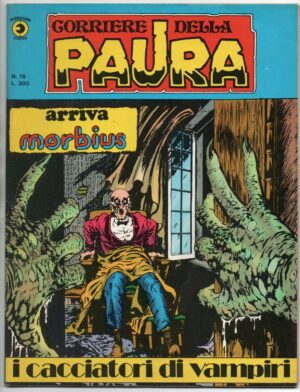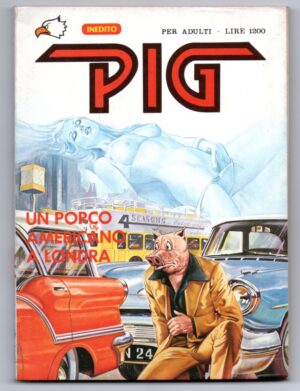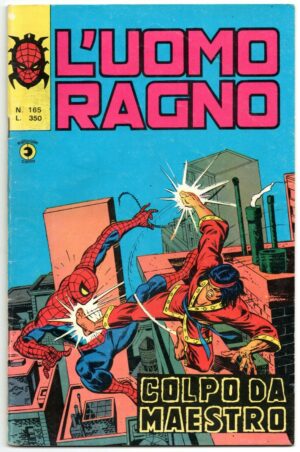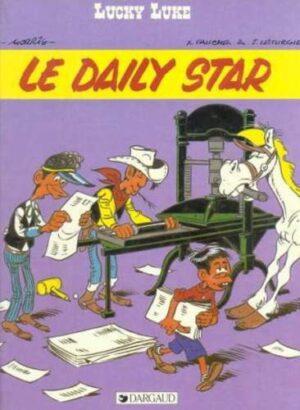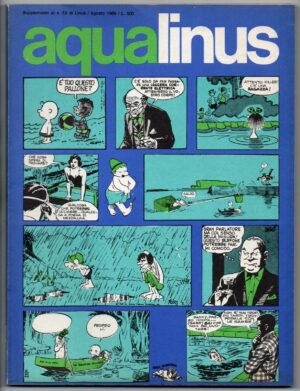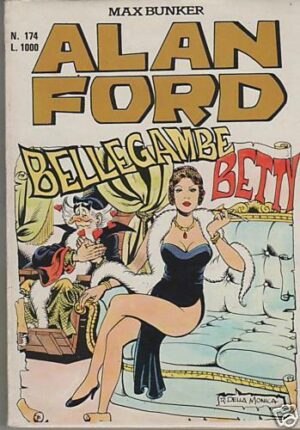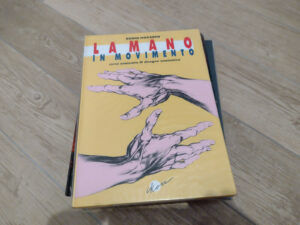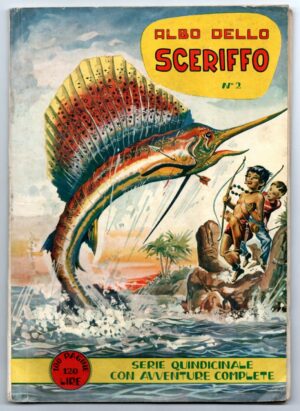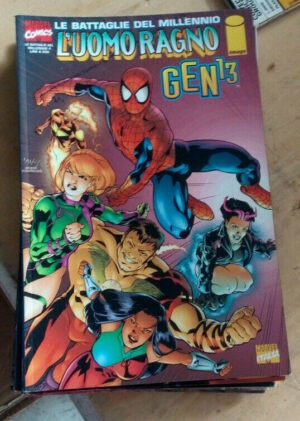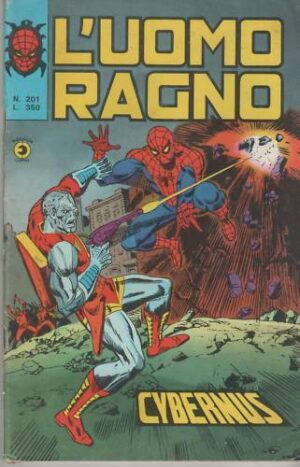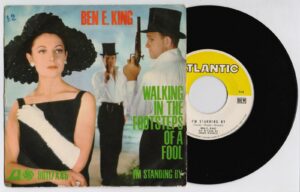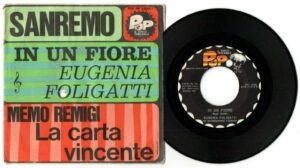Descrizione
cod. TF
PREMESSA: LA SUPERIORITA’ DELLA MUSICA SU VINILE E’ ANCOR OGGI SANCITA, NOTORIA ED EVIDENTE. NON TANTO DA UN PUNTO DI VISTA DI RESA, QUALITA’ E PULIZIA DEL SUONO, TANTOMENO DA QUELLO DEL RIMPIANTO RETROSPETTIVO E NOSTALGICO , MA SOPRATTUTTO DA QUELLO PIU’ PALPABILE ED INOPPUGNABILE DELL’ ESSENZA, DELL’ ANIMA E DELLA SUBLIMAZIONE CREATIVA. IL DISCO IN VINILE HA PULSAZIONE ARTISTICA, PASSIONE ARMONICA E SPLENDORE GRAFICO , E’ PIACEVOLE DA OSSERVARE E DA TENERE IN MANO, RISPLENDE, PROFUMA E VIBRA DI VITA, DI EMOZIONE E DI SENSIBILITA’. E’ TUTTO QUELLO CHE NON E’ E NON POTRA’ MAI ESSERE IL CD, CHE AL CONTRARIO E’ SOLO UN OGGETTO MERAMENTE COMMERCIALE, POVERO, ARIDO, CINICO, STERILE ED ORWELLIANO, UNA DEGENERAZIONE INDUSTRIALE SCHIZOFRENICA E NECROFILA, LA DESOLANTE SOLUZIONE FINALE DELL’ AVIDITA’ DEL MERCATO E DELL’ ARROGANZA DEI DISCOGRAFICI .
JETHRO TULL
aqualung
Disco LP 33 giri , chrysalis / phonogram , 040 1044A , 1973 reissue, Italia, green label
OTTIME
CONDIZIONI, vinyl ex+ , cover ex++/NM

| « Sitting on a park bench eyeing little girls with bad intent. » | |
|
(da “Aqualung”)
|
| « The bloody Church of England in chains of history requests your earthly presence at the vicarage for tea. » | |
|
(da “My God”)
|
Aqualung è il quarto album della band progressive rock inglese Jethro Tull, pubblicato nel 1971.
L’album colpì il pubblico grazie alla celebre copertina raffigurante un barbone, molto somigliante al leader del gruppo Ian Anderson. L’immagine impressiona soprattutto per la crudezza dell’espressione e dello sguardo del volto di Aqualung, cui fa da contraltare un manifesto che reclamizza eleganti e dispendiose vacanze natalizie.
Pare che il titolo dell’album derivi dal rantolo roco del barbone
simile – secondo Anderson – al rumore di un respiratore artificiale (l’Aqualung ne è un modello particolare).
I testi raccontano in maniera aspra la vita di Aqualung,
fallimentare a scuola come nelle relazioni interpersonali. Unico suo
interlocutore possibile resta Dio
al quale in punto di morte – in un ultimo rantolo rabbioso – Aqualung
dedica solo parole sprezzanti. I Jethro Tull scegliendo un barbone
pedofilo come protagonista del loro concept album vogliono esprimere
una critica alla società. Il senso di smarrimento che ne consegue porta
l’uomo a perdere ogni certezza e ad odiare il mondo stesso. Aqualung
impreca contro Dio e Lo accusa delle proprie sofferenze.
Grande prova di maturità per i Jethro Tull, che dimostrarono in Aqualung e nel successivo Thick as a Brick
di essere molto più che “menestrelli progressivi”, come forse potevano
apparire alla luce delle prove precedenti. L’album contiene alcuni dei
cavalli di battaglia del gruppo, a partire dalla title track, immancabile nelle esibizioni live dei Tull così come Locomotive Breath e My God
che è senza dubbio uno dei brani più significativi della carriera della
band. Il gruppo lo registrò una prima volta durante le session di Benefit,
ma lo accantonò perché giudicò quella versione poco riuscita. Il brano
venne comunque suonato in tour per parecchio tempo, e fu una delle
composizioni preferite da Anderson stesso.
Inizialmente, l’album doveva chiamarsi proprio My God,
ma il titolo venne cambiato perché sul mercato era apparsa un’incisione
pirata omonima, che aveva una qualità audio talmente buona che avrebbe
potuto facilmente essere scambiata per una pubblicazione ufficiale. Il
brano, a pari merito della title-track, resta comunque uno dei più
eseguiti dal vivo ed è a tutt’oggi e uno dei più apprezzati; è da
segnalare la “cover” di Cross-Eyed Mary incisa dagli Iron Maiden disponibile nella raccolta “Best of B-Sides”.
Aqualung is the fourth studio album by the rock band Jethro Tull, released in 1971. It was their first album with John Evan as a full-time member, their first with new bassist Jeffrey Hammond and last album featuring Clive Bunker on drums. The first side of the LP
contains a series of six character sketches, including two sketches of
people of questionable repute (title character Aqualung and Cross-Eyed
Mary) and two autobiographical tracks including “Cheap Day Return”,
written by band leader Ian Anderson
while returning from a visit to his critically ill father. The overall
message of the lyrics on the second side is said to be “pro-God but
anti-church”, and makes the statement that organized religion can
actually restrict a person’s relationship with his God instead of
enhancing it. Anderson was not intending to make Aqualung a concept album.

Etichetta: Chrysalis
Catalogo: 0401044 A
Data di pubblicazione: 1973
Matrici / etchings / run out groove numbers : ILPS 19145 – 1 / ILPS 19145 – 2
Data Matrici : 8/6/71 (only on A side)
- Supporto:vinile 33 giri
- Tipo audio: stereo
- Dimensioni: 30 cm.
- Facciate: 2
- Gatefold textured sleeve / copertina apribile con cartoncino esterno simil-telato, green label , lyrics inner sleeve
Tracce
Tutte le canzoni sono state scritte da Ian Anderson se non indicato diversamente.
AQUALUNG
- Aqualung (Ian Anderson/Jennie Franks) – 6:34
- Cross-Eyed Mary – 4:06
- Cheap Day Return – 1:21
- Mother Goose – 3:51
- Wond’ring Aloud – 1:53
- Up To Me – 3:14
MY GOD
- My God – 7:08
- Hymn 43 – 3:15
- Slipstream – 1:12
- Locomotive Breath – 4:23
- Wind Up – 6:01
 |
|
Players |
|
Dating from at least the Electric Prunes’ Mass In D Minor,
rock and religion have evinced an unlikely affinity for each other.
Eric Clapton, Peter Green, Jeremy Spencer, Peter Townshend, John
Lennon, George Harrison (and let us not forget the Reverend Richard
Penniman) have all at some point dedicated themselves and their music
to God in his myriad varieties. On the heels of Tommy and Jesus Christ Superstar, Jethro Tull’s Ian Anderson joins this heady list.
Tull is one of our most serious and intelligent groups, and Anderson’s choice of subject for Aqualung
— the distinction between religion and God — is witness to that.
Further, Tull has a musical sophistication to match its thematic
ambitions. Where This Was, their first album, was aimless and disorganized, Stand Up, with its dabbling in ethnic and classical forms, was eclectic in the best sense. Out of that experimentation was forged in Benefit a sound which finally provided the band with a concrete identity.
Once a group has arrived at a coherent style, the next logical step
is a concept album, and it is on the shoals of concepts that many a
band runs aground. Often such albums lack the hint of self-irony, which
is basic to great rock and roll, and therefore come off sounding
pompous. Ultimately an album like Tommy, for example, must stand or fall on its quality as a collection of songs; the thematic gloss is absolutely secondary.
Aqualung is the album’s lead character, and is so named for his
rheumy cough. Side one consists of a series of seedy vignettes drawn
from modern secular English life, while the printed lyrics are cast in
Gothic lettering to emphasize the album’s liturgical basis. The title
song depicts the beggar in all his shabbiness and lechery. “Aqualung”
is actually three songs; as the different moods of the narrator unfold,
the music changes accordingly. The initial melodic statement sung in a
harsh, surly voice is ugly and plodding; it then shades into something
milder and more sympathetic, then into something which rocks a little
more.
Another of society’s dregs, cross-eyed Mary the slut, of the song of
the same name, is the object of Aqualung’s attentions. Anderson sounds
equally disapproving here. “Mother Goose” is the kind of song that
Anderson writes best. As in “Sossity” on Benefit, he uncannily
captures the feel of a real Elizabethan madrigal (a consort of
recorders here helps it get across). It’s a song about a Hampstead
fair, and is filled with descriptive detail which is at once archaic
and up to date. Lyrics and melody mutually accomplish the same purpose,
for both express the continuity of English life.
Side two, subtitled “My God,” deals more explicitly with religion.
The nub of the issue is Christian hypocrisy, how people manipulate
notions of God for their own ends. There is some rather obvious talk of
plastic crucifixes, Blakean allusions to locking “Him in His golden
cage,” and invective; “The bloody Church of England/In chains of
history/Requests your earthy presence at/The vicarage for tea.” Beneath
the accusatory tone is a moving musical theme. Again, the structure is
constantly shifting. There are stately hymnal changes, a jazzy flute
break, a pomp-and-circumstantial motive which, when inverted, assumes a
more chromatic, modern queasiness. The gamut of religious experience is
encompassed in this song.
“Wind Up” winds up the album and embodies most of the album’s
difficulties. While Anderson is adept at conceiving a musical
approximation of an idea, his lyrics are overly intentional, ponderous,
and didactic. It would be possible to ignore the lyrics, as lyrics can
usually be ignored, except that Anderson sings them so
melodramatically. Nor is his theatricality appropriate to the ideas or
words. The over-enthusiastic delivery is probably meant to compensate
for his inherent vocal limitations, but the original problem is
Anderson’s choice of subject. At a time when the more arcane varities
of religious experiences are trumpeted far and wide, and atheism and
agnosticism still more than hold their own, it is difficult for the
modern temper to get worked up over good old-fashioned Christian
hypocrisy. When Anderson sufferingly sings–
So I asked this God a question and by way of firm reply,
He said “I’m not the kind you have to wind up on Sundays.”
So to my old headmaster (and to anyone who cares);
Before I’m through I’d like to say my prayers–
“I don’t believe you: you got the whole damn thing all wrong–
He’s not the kind you have to wind up on Sundays.”
–there is something depressingly anti-climactic about it all. There is a lot of misplaced emotion on this record.
Thus, despite the fine musicianship and often brilliant structural
organization of songs, this album is not elevated, but undermined by
its seriousness.

There are two qualities in particular that make this album Jethro’s
finest: taste and variety, neither of which were present in such
abundance in their work before. The material ranges from gentle love
songs — ‘Wond’ring Aloud’ — to the percussive rock cuts like
‘Locomotive Breath’ with others in between like ‘Mother Goose’, an old
English flavoured song, cutely phrased and unusually delivered. Even in
‘Locomotive Breath’ and ‘Wind Up’, the other heavy track, there’s light
and shade with John Evan’s piano introductions providing a contrast to
what follows.
Produced by Ian Anderson, who wrote all the selections with the
exception of the title track lyrics written by his wife, and manager
Terry Ellis, the whole album has been handled tastefully. David
Palmer’s orchestrations on ‘Wond’ring Aloud’ and ‘Slipstream’; Martin
Barre’s guitar licks on ‘My God’; Anderson’s flute fills and the
varying echoey effects on ‘Aqualung’ are all interesting but never
intrude. Anderson’s acoustic guitar work is another revelation: he has
no pretensions of greatness in this department, but he does the job
admirably and the five members of the group are a very solid unit now.
From the packaging to the music it contains, this album is a
complete work and this is from a group who were considered basically a
live act. They improve every time out.
The album was one of the first to be recorded at the newly opened studios of Island Records in Basing Street, London. Led Zeppelin were mixing their untitled fourth album (Led Zeppelin IV)
at the same time. In an interview on the 25th anniversary edition of
the album, Anderson reportedly said that trying to record in their
studio was very difficult. There were two recording studios at the
location; Led Zeppelin worked in the smaller studio while Tull got the
larger, which was probably the original chapel based on Anderson’s description of its “orchestral” feeling.
Many of the songs are primarily acoustic. “Cheap Day Return”, “Wond’ring Aloud” and “Slipstream” are short, completely acoustic “bridges”, and “Mother Goose” is also mostly acoustic.
In an interview on Aqualung Live (2005) (track 16) Ian Anderson claimed that:
I always said at the time that this is not a concept album; this is
just an album of varied songs of varied instrumentation and intensity
in which three or four are the kind of keynote pieces for the album but
it doesn’t make it a concept album. In my mind when it came to writing
the next album, Thick as a Brick, was done very much in the sense of: ‘Whuh, if they thought Aqualung
was a concept album, O-O-K, we’ll show you a concept album.’ And it was
done as a kind of spoof, a send-up, of the concept album genre. …
But, Aqualung itself, in my mind was never a concept album. Just a, just a bunch of songs.
AQUALUNG

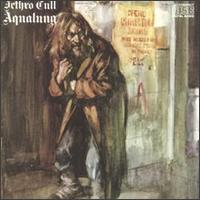
Year Of Release: 1971
Record rating = 9
Overall rating = 12
A must for every prog lover. But I bet you all know it already.
Best song: LOCOMOTIVE BREATH
Track listing: 1) Aqualung; 2)
Cross-Eyed Mary; 3) Cheap Day Return; 4) Mother
Goose; 5) Wond’ring Aloud; 6) Up To Me; 7)
My God; 8) Hymn 43;
9) Slipstream; 10) Locomotive Breath; 11)
Wind Up.
American audiences needn’t be introduced to this album – as far as I
know, lots of its songs are constantly recycled on the radio, and overall,
if Jethro Tull are to be associated with anything by anybody, it’s
probably the menacing heavy riff which opens the title track. The biggest
ever commercial whopper for Tull, it is that good indeed – even though
the same American audiences were slow on the move to really appreciate
Stand Up. Anyway, for aspeaking out loud, it’s tons better than
Benefit, and a true all-time classic. I may easily say that there’s
not a single bad song on the album – for the very last time in the entire
Tull career (barring the one song albums, of course, one of which is all
good and the other… ahem… well, read on, oh gentle listener).
Maybe it has something to do with a radical change in line-up – this is
where both John Evan and Jeffrey Hammond-Hammond stand up to the blackboard
(well, Evan did play some keybs on Benefit, but that doesn’t count
– he wasn’t even a legitimate band member). Maybe Anderson was desperately
looking for FM radio hits. Maybe he just had a good day. I don’t know.
What I know is that this is the last Tull record which is listenable at
first listen and memorable at first memory (forgive me my silly analogies).
Actually, it is something of a bridge between the lovely early blues-psycho
days and the later murky overblown pompous fantasy days. This is the first
of Anderson’s multiple concept albums, but the concept is still rather
just a basis for the songs than vice versa. The plot is as follows: Man
created God and God created Aqualungs. Or was it the opposite? Oh, never
mind. It’s all written in a parody on John’s Gospel placed on the album
cover. In other words, it’s a stupid, self-indulgent concept that bashes
organized religion and sometimes borders on bashing the very essence of
religion – especially on tracks like ‘My God’, although Anderson always
takes care so as not to cross the thin borderline completely. That’s not
to say that the lyrics are bad: the underlying ideas and principles are
very simple, but this is Anderson at his most poetic and involving, and
his imagery has never been stronger, considering that on here he’s still
able to uphold the balance between form and content – since Thick As
A Brick and particularly later on, his lyrics would go off the deep
end completely.
Let us not forget the immaculate melodies, though. The radio classics include
the multi-part title track, highlighted by the above-mentioned cool riff,
very expressive singing that ranges from a special Anderson-style ‘vomit-inducing
sneer’ to passionate and heartfelt, and a mad, ecstatic, rise-to-a-shattering-climax
guitar solo courtesy of Martin Barre; ‘Cross-Eyed Mary’ with its gorgeous
crescendo in the flute-dominated introduction and Anderson’s bitter condemnation
of the middle class society; and especially my favourite – the bad luck
anthem ‘Locomotive Breath’. Have you ever heard a riff imitating the slow
progress of a train? Then you haven’t heard ‘Locomotive Breath’, a song
perfect from the first notes of the John Evan Bach-imitating piano introduction
to the majestic fade out with Ian singing that ‘there’s no way to slow
down’. If it ain’t my favourite song by Jethro Tull, that’s just because
it isn’t on my turntable at the present moment. Yes, I admit it’s rather
naive for a person who’s gone through the entire Tull catalog to announce
that his favourite song by the band is the one radio standard that’s most
popular among the beer-drinkin’ crowds, but what can I do if the song’s
pure and clear genius? Forgive me, lovers of Tull. At least I don’t abuse
beer.
But even if you don’t hear the other tracks on the radio every five minutes,
that doesn’t mean they aren’t worth of radioplay. ‘Hymn 43’ may not be
great, but, once again, the riff is an absolute classic (and this is where
you’ll find the famous line about how ‘if Jesus saves, he’d better save
himself…’, so much hated by orthodoxal church abiders who intentionally
neglect that the second half of the phrase goes ‘…from the gory glory
seekers who use his name in death’). Barre and Jeffrey Hammond-Hammond
chug along on the track like mad, transforming it into a true hard rock
masterpiece. The plaintive, desperate ‘Up To Me’ is based on a cool repetitive
flute line, ‘Mother Goose’ is just a funny tune (having nothing
to do with the notorious rhymes), and the lengthiest track on here – the
conceptual climax of ‘My God’ – also manages to keep the listener’s attention,
going off from rifffests onto bits of Bach onto bits of Russian folk music
(not that Anderson knew very well how to handle Russian folk music, but
at least he made an entertaining try). Plus there are several short acoustic
links which all the Tull-haters try to accentuate by saying all kinds of
things about how they suck and so on, but I personally don’t see any trouble
with them: Anderson is a decent classical guitar player, and anyway all
the three are shorter than two minutes. No need to worry, Tull-haters!
‘Wind-Up’ is the only song I could live without on here, but maybe it’s
just because it’s placed at the end. I’ve always thought that the best
songs on any album should be placed in the beginning (so as not to let
down the listener from the very start) and in the end (so as not to leave
the feeling of being bored and deceived). As you see, Ian rarely fulfills
the second part of the statement. But it’s not bad either way.
It’s still a little bit weaker than Stand Up, in my opinion, which
is why the rating is a wee bit lower; the acoustic links and ‘Wind-Up’
and some instrumental bits on ‘My God’ and… well, little nasty tidbits
now and there, couldn’t really grab ‘em by the scruff o’ the neck cause
they’re so tiny. But “near-immaculate classic” would be a suitable
definition, too, and an album where many of the more reserved Tull lovers
set a fat point. However, with all due respect, we’ll try and go dig a
little deeper to see that Anderson’s talents were not yet exhausted. By
no means no.
Cover
The album’s original cover art by Burton Silverman
features a portrait of the title character, Aqualung, which many have
considered to be inspired by Ian Anderson, though Anderson denies it.
The rear cover shows a less-lecherous looking portrait of the same
character sitting on a street-curb with a dog, a scene reminiscent of
the band’s photographic portrait with age make-up and a pack of dogs on
their first album, This Was.
The inner art on the fold-out cover showed portraits of the five band
members in typical stage attire performing irreverent acts in a
chapel–perhaps simultaneously depicting the theme of the second side
of the LP while commemorating the band’s recording-studio environment.
Release
Aqualung peaked at #7 on the Billboard Music Charts‘ North American pop albums chart and number 4 on the UK Album Chart. The single “Hymn 43” hit #91 on Billboard’s pop singles chart. In 2003, the album was ranked number 337 on Rolling Stone magazine’s list of the 500 greatest albums of all time. The orchestrals were also arranged by Dee Palmer (named David Palmer at the time).
Aqualung was one of only two Jethro Tull albums which were released in quadraphonic sound, the other being War Child.
This version featured several differences from the stereo release.
“Wind Up” is in a higher key
(three semitones), and “Aqualung” begins with two solo repetitions of
the opening riff instead of one.
Aqualung
La più famosa canzone nella storia della band, essa riassume la dura
vita di un senza tetto. Riconoscibilissima per il famoso riff iniziale,
viene riproposta in tutte le apparizioni live del gruppo.
Cross-Eyed Mary
Anche in questo pezzo viene raccontata una vita difficile, quella di
una ragazza di famiglia povera che si prostituisce concedendosi però
soltanto a uomini che versano nelle sue stesse condizioni economiche,
se non peggiori. Nel testo viene citato anche Aqualung.
Cheap Day Return
Pezzo acustico di breve durata, scritta da Anderson in stazione mentre aspettava il treno che lo avrebbe portato a Blackpool per trovare il padre malato in ospedale. Il “cheap day return” è un tipo di biglietto ferroviario.
Mother Goose
Altro pezzo acustico di durata maggiore, il testo non esprime alcuna
idea particolare, si tratta di una serie di immagini unite l’una
all’altra come un collage senza alcun filo conduttore. Immagini che
Anderson ha raccolto durante una passeggiata a Hampstead Heath,
com’egli stesso afferma in un’intervista pubblicata sul The Complete Lyrics Book.
Wond’ring Aloud
Terza canzone acustica dell’album, in essa l’autore elogia il
sentimento dell’amore, sia esso in una relazione sentimentale o
all’interno di un rapporto di amicizia o di qualsiasi altro genere.
Armonia, felicità e un senso di rilassatezza trasudano dalle parole e
dalla melodia. La parola chiave è “giving” (“dare”): Anderson vuole
trasmettere la convinzione di quanto sia importante il gesto del
donare, dell’offrire, non soltanto per l’altro ma anche per se stessi.
La canzone deriva dalla precedente Wond’ring Again, edita sull’album Living in the Past.
Up To Me
Come in Mother Goose anche questa canzone offre una serie di
immagini. In essa viene riassunta la vita della “lower class”, la
classe operaia: un appuntamento galante in un bar, una rissa in un
locale e altre immagini si susseguono.
My God
Si tratta di uno dei cavalli di battaglia della band, una pesante critica nei confronti della Chiesa Anglicana, definita “bloody” (“sanguinaria”). Di particolare effetto il lungo assolo centrale di flauto traverso.
Hymn 43
Un altro pezzo che tratta i temi della religione; in Hymn 43 Anderson critica l’ipocrisia della gente, nella fattispecie i cristiani,
che “predicano bene e razzolano male”. L’autore non vuole prendersela
con la religione in quanto tale, ma con tutti quelli che affermano di
esserne i seguaci salvo poi comportarsi nel modo totalmente opposto a
quanto essa indica.
Slipstream
Altra breve traccia acustica in cui l’autore fotografa la miseria
della vita umana: nasci, e subito dopo aver iniziato una vita riempita
dai beni materiali, muori. Nel testo viene menzionato “il cameriere di
Dio”, ovvero San Pietro.
Locomotive Breath
Altro cavallo di battaglia della band, la canzone viene sempre
suonata in concerto. Il testo parla dell’inesorabile scorrere della
vita, paragonata ad un treno che non ha modo di fermarsi.
Wind Up
L’ispirazione per questa canzone è venuta ad Anderson dalla sua
stessa infanzia, quando era costretto dai genitori ad andare in chiesa.
In particolare esprime tutto il suo disaccordo sul fatto che i figli
debbano seguire le credenze dei genitori e a tal proposito è
emblematico il verso “accident of birth” (“incidente di nascita”): la
“scelta” della religione nella stragrande maggioranza delle persone è
determinata solo dal luogo in cui esse nascono e crescono e
dall’ambiente sociale in cui vivono, non da una propria effettiva
convinzione.

Released at a time when a lot of bands were embracing pop-Christianity (à la Jesus Christ Superstar), Aqualung
was a bold statement for a rock group, a pro-God antichurch tract that
probably got lots of teenagers wrestling with these ideas for the first
time in their lives. This was the album that made Jethro Tull a fixture
on FM radio, with riff-heavy songs like “My God,” “Hymn 43,”
“Locomotive Breath,” “Cross-Eyed Mary,” “Wind Up,” and the title track.
And from there, they became a major arena act, and a fixture at the top
of the record charts for most of the 1970s. Mixing hard rock and folk
melodies with Ian Anderson‘s
dour musings on faith and religion (mostly how organized religion had
restricted man’s relationship with God), the record was extremely
profound for a number seven chart hit, one of the most cerebral albums
ever to reach millions of rock listeners. Indeed, from this point on, Anderson and company were compelled to stretch the lyrical envelope right to the breaking point. [In the digital age, Aqualung
has gone through numerous editions, mostly owing to problems finding an
original master tape when the CD boom began. When the album was issued
by Chrysalis through Columbia Records in the mid-’80s, the source tape
was an LP production master, and the first release was criticized for
thin, tinny sound; Columbia remastered it sometime around 1987 or 1988,
in a version with better sound. Chrysalis later switched distribution
to Capitol-EMI, and they released a decent sounding CD. Chrysalis also
issued a 25th anniversary edition in 1996.]
|
||||||||||||||||||||||||||
|
Già L’anno Modalità Proprio Con Alla |
||||||||||||||||||||||||||

| Una volta definito l’acquisto, paga immediatamente con la tua carta di credito tramite PayPal! |

|

